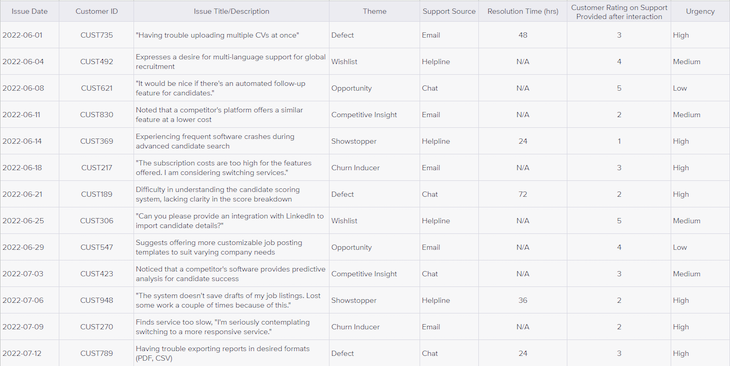Customer support is the unsung hero for many products. It acts as the first line of defense when unforeseen issues arise. Customer support personnel experience customers’ frustrations and challenges firsthand, offering a unique perspective on the product’s real-world performance.

Product managers use various sources of “evidence” to glean insights about their products, such as analytics, market research, surveys, and sales inputs, to name a few. However, customer support provides access to insights not even customer interviews can offer.
Support teams witness genuine customer reactions during critical moments when a product’s performance is paramount. They understand the urgency behind particular requests and have a keen sense of edge cases the product might not address adequately. They also grasp the customers’ intentions in these scenarios.
To put it simply, customer support has the most direct exposure to the voice of the customer in real-time. This is why they should play a crucial role during product strategy discussions.
In products I’ve personally been involved with, feedback from customer support has significantly influenced strategy and direction. For instance, while leading a product team for an applicant tracking system — software designed to assist organizations in sourcing and hiring talent — I evaluated our recently launched interview scheduling module.
The feature’s low usage suggested that it wasn’t resonating with our customers. Our customer interviews indicated that recruiters preferred their scheduling tools.
However, insights from customer support painted a different picture. They pointed out that the feature’s onboarding process was intricate, leading them to guide many users through calendar integration and sending invites to multiple candidates.
Furthermore, the majority of our customers used Microsoft technologies and sought integration with Outlook. Our scheduling tool was primarily compatible with Google Calendar and iCal, causing users to avoid it.
This revelation reshaped our understanding of the module, prompting us to reallocate resources to improve the user experience. This decision yielded significant benefits in the subsequent quarter.
In numerous organizations, customer support is often perceived as merely a team that maintains the status quo. Yet, given the sheer number of interactions they have with customers, support representatives are frequently a source of valuable insights.
To truly recognize the contribution of customer support to product strategy, you must first understand the range of insights they offer. Leveraging insights from customer support can help product managers identify things like:
Support can pinpoint areas of the product that are defect-prone and demand intensive troubleshooting. For instance, in recruitment software, customer support might address a multitude of resume parsing challenges due to the diverse resume formats.
Customer support is adept at spotting product workflows that regularly perplex users or lack intuitiveness. Especially in products designed for self-service, customer support can shed light on where the product is lacking and the challenges users face.
For instance, our support team frequently highlighted how our interviewing module was less than satisfactory due to insufficient integrations.
There are times when users avoid a feature either because they don’t grasp its relevance or fail to maximize its potential. Support teams are well-positioned to identify these instances.
For example, when we introduced the “Requisitions” feature (an internal approval request to initiate hiring for a role) in our applicant tracking system, a significant segment of our SMB customers never engaged with it. Support provided insights that each organization had its unique workflow, and many were uncertain about aligning the feature with their processes.
Customer support can underscore business or industry-tailored requirements in diverse sectors they regularly serve.
For instance, our support representatives noted that when interacting with government agency staff, they frequently encountered inquiries regarding the background references module and the need to capture official documents during job applications.
Support teams are often privy to customer desires and requirements. Support leads can enumerate direct customer requests or highlight product areas needing enhancement.
For example, our support representatives often relayed frequently requested integrations and potential automation solutions that could simplify tasks.
For organizations offering priority support to select enterprise clients, these support teams develop a profound grasp of client needs and desires. Should these clients decide to discontinue their service, support typically knows the primary reasons.
For instance, our representatives alerted us when a client considered switching to another provider in search of recruitment software combined with a payroll and benefits management suite.
Support can rapidly discern which features are responsible for the majority of user challenges. For product teams, gauging the success of a new feature often involves merging their analytics with the nature of incoming support queries.
On occasion, a customer might express interest in a feature not included in their current subscription, leading support to suggest an upgrade. In these interactions, customers often seek clarity on different subscription tiers and share their perspectives on pricing, value propositions, and the reasons behind their upgrade decisions or hesitations.
The insights garnered from customer support can vary significantly based on whether a product adheres to a B2B or B2C model.
For B2C products, customer support teams often interact with a vast number of end users, especially if the product has achieved product-market fit and is in a growth phase. This extensive interaction allows them to discern wide-ranging trends and patterns related to user problems, preferences, and behaviors. Directly interfacing with users, B2C support teams can provide nuanced insights into real consumer-product interactions, pinpointing areas of dissatisfaction or confusion.
In contrast, with B2B products, the individual purchasing the software often differs from the actual end user. Product teams typically communicate with a single representative from the customer organization responsible for account-related discussions. While this representative consolidates feedback from internal product users, some details might get overlooked or lost.
However, support teams gather raw, unfiltered data straight from all end-users. This direct interaction grants them an unobstructed view of the specific challenges or deficiencies users encounter. Interestingly, it also imparts them with specialized domain knowledge and introduces them to intricate workflow use cases—information invaluable during product planning.
For instance, during my tenure developing a recruitment product, our support team detected multiple issues users faced with resume parsing and form customizations —c hallenges we wouldn’t typically uncover when liaising with our primary business contacts.
When devising a product strategy, product managers strive to align customer needs with business objectives.
A well-rounded product strategy usually addresses three principal aspects:
Customer support insights can influence each of these areas.
To elucidate with an example, let’s consider Calendly, a renowned appointment-scheduling tool.
Customer support can shed light on absent features or potential competitive threats based on their interactions. For instance, Calendly’s support team might identify businesses expressing interest in lead routing rules for their sales teams. They might also frequently hear mentions of competitors like Chilipiper.
Armed with this information, product managers and marketers could tailor their strategies to target this specific audience segment, refining their product offerings and messaging.
Support agents, with their pulse on user sentiments, might spot patterns signaling impending churn. For example, they might note Calendly users lamenting the absence of an integration with a specific CRM.
Product managers could harness this feedback to delve deeper, and if a tangible link is established, they might emphasize building more integrations and aligning with popular tech ecosystems.
Support staff might observe enterprise clients seeking features like single sign-on (SSO), enhanced branding options, and role-based access controls. Such insights can steer product teams toward a more enterprise-centric approach in their strategy, positioning these users toward a higher-value subscription tier.
Customer support can funnel an abundance of feedback to product managers. Given the volume, it can be daunting to process and shape this feedback into a coherent strategy. Therefore, product managers must learn how to prepare, organize, and distill these learnings.
Here are steps to consider when integrating customer support insights into your product strategy:
Create buckets like:
Consider the product areas needing more transparency. For a grocery delivery service, for example, this could encompass registration and authentication, marketplace search functionality, coverage of grocery stores, product listing diversity, checkout experience, and delivery feedback, among others.
Prepare to capture from your support footprint, which might span multiple channels such as:
Determine how and where tickets are documented. Ideally, all incoming issues should be recorded and consolidated in customer support software for easier analysis. However, if not all feedback is documented, you might need a hybrid approach: examine logged tickets and gather qualitative feedback from support agents.
Even with documented issues, direct conversations with customer support reps can offer deeper insights and context. If your support team is sizable, consider sending out a survey and then engaging in detailed discussions with a select group. Focus on areas with recurring feedback, and always document your findings.
Your spreadsheet should include the following columns:
Export all data from your support software and combine it with feedback from surveys and interviews:

While manual tagging is an option, tools like SheetGPT can automate this process with decent accuracy. However, it’s good practice to randomly sample and validate the results.
For phone support that offers textual transcripts, consider exporting these to another Google Sheet. Then, use tools like SheetGPT or ChatGPT’s Code Interpreter plugin to quickly organize and summarize the feedback.
Reflect on questions such as:
Use these reflections as foundational inputs during product strategy brainstorming sessions.
Sharing a concise summary of these insights with leadership and peer teams can be beneficial for collective understanding.
Engaging with customer support shouldn’t be reserved for strategy document submissions. Regular interactions can enrich a product manager’s perspective, especially after the launch of new features.
Some best practices include:
For support interviews, a quarterly cadence is a good starting point, aligning with the evolving roadmap. Additionally, a robust product strategy should also consider how the product team can enhance customer support processes. Keep this in mind when gathering feedback.
While delving into the vast array of customer support tickets and feedback, it’s easy to become overly focused on specific issues. As you navigate through this process, it’s crucial to remember that you’re aiming to address overarching challenges faced by your customer base, rather than individual tickets.
Some guidelines to keep in mind include:
Each piece of feedback represents just one perspective. As a product manager, your focus should be on overarching themes rather than reacting impulsively to singular issues, unless it pertains to a straightforward concern like a legal infringement. Resist the urge to implement changes based solely on one-off comments.
Tune into the language customers use. Exaggerated feedback requires cross-validation. Understand that emotions can drive certain responses, so it’s essential not to accept every comment without scrutiny.
Not all feedback holds equal weight. Evaluate comments through the lens of your ideal customer profile (ICP). Pay attention to the source of feedback. If it originates from users employing your product in unintended ways, their feedback might not align with your product strategy.
As you navigate through customer support insights, ensure you emphasize areas consistent with your company’s broader strategy and vision. Even if certain suggestions seem attractive, they might not align with your product’s long-term objectives.
When interpreting feedback shared by customer support teams, be aware of potential biases. Representatives might inadvertently emphasize or minimize certain concerns based on their personal views. Broad statements like “everyone is demanding this feature” or “the payment process is consistently failing” warrant further investigation and data validation.
Customer support, often relegated to the sidelines, is a treasure trove of insights for product teams. Their firsthand experience with user challenges and unfiltered reactions is unparalleled.
However, harnessing these insights is no small task. Product managers need a proactive approach, not just in capturing or examining feedback, but in discerning what truly matters. This entails establishing robust systems and honing the skill of asking pertinent questions.
A close collaboration with customer support equips product managers with a more attuned ear to the voice of the customer, ensuring their strategies are anchored in real-world issues rather than hypothetical scenarios.
Featured image source: IconScout
LogRocket identifies friction points in the user experience so you can make informed decisions about product and design changes that must happen to hit your goals.
With LogRocket, you can understand the scope of the issues affecting your product and prioritize the changes that need to be made. LogRocket simplifies workflows by allowing Engineering, Product, UX, and Design teams to work from the same data as you, eliminating any confusion about what needs to be done.
Get your teams on the same page — try LogRocket today.

Emmett Ryan shares how introducing agile processes at C.H. Robinson improved accuracy of project estimations and overall qualitative feedback.

Suvrat Joshi shares the importance of viewing trade-off decisions in product management more like a balance than a compromise.

Great product managers spot change early. Discover how to pivot your product strategy before it’s too late.

Thach Nguyen, Senior Director of Product Management — STEPS at Stewart Title, emphasizes candid moments and human error in the age of AI.